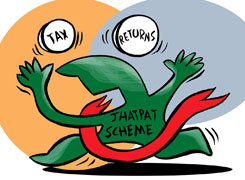Ramalingam Kalirajan |8100 Answers |Ask -Follow
Mutual Funds, Financial Planning Expert - Answered on May 19, 2024
He has an MBA in finance from the University of Madras and is a certified financial planner.
He is the director and chief financial planner at Holistic Investment, a Chennai-based firm that offers financial planning and wealth management advice.... more

Sir, I am a retired Air Force veteran aged 59 yrs. My annual pension for FY 2023- 24 is 8 lakhs, out of which i have ppf subscription of 1.5 lakhs, mutual fund sip annually of 1.56 lakhs. I pay home rent also @ Rs 16000 per month from my pension. I have a TDS from pension amounting to Rs 40000/- in 2023 - 24. This year due to maturity of KVP I have income from other sources of Rs 4.1+ 40000+ 50000= Rs 5 lakhs. I already have paid 40000 as TDS, am paying 40000/- as advanced tax by 26 Mar 24. How much extra will be my tax liability for 2023-24? How can i save tax, please advice as i have no home loan, no health insurance etc.
Evaluating Your Tax Liability
Pension Income and PPF Subscription
Your annual pension of 8 lakhs for FY 2023-24 is a significant source of income, subject to taxation.
The PPF subscription of 1.5 lakhs qualifies for deduction under Section 80C, reducing your taxable income.
Mutual Fund SIP and Other Sources of Income
The annual mutual fund SIP of 1.56 lakhs contributes to your investment portfolio but does not offer tax benefits.
Income from other sources, including the maturity of KVP and TDS, adds to your total taxable income.
Rent Payment and TDS
Paying home rent from your pension reduces your taxable income but does not qualify for tax deductions.
TDS from your pension and advanced tax payments are essential for compliance but may increase your tax liability.
Estimating Additional Tax Liability
Calculating Taxable Income
Deducting allowable exemptions and deductions from your total income will determine your taxable income.
Your tax liability will depend on the applicable tax slab rates for FY 2023-24.
Considering Tax Deductions
Exploring additional tax-saving avenues like Senior Citizen Savings Scheme (SCSS), Tax-saving Fixed Deposits (FDs), or National Pension System (NPS) contributions can help reduce your tax liability.
Tax-Saving Strategies
Leveraging Senior Citizen Benefits
As a senior citizen, you may benefit from higher tax exemption limits and additional tax-saving opportunities.
Senior Citizen Savings Scheme (SCSS) and Pradhan Mantri Vaya Vandana Yojana (PMVVY) offer attractive interest rates and tax benefits.
Maximizing Section 80C Deductions
Utilize the full potential of Section 80C deductions by exploring eligible investments such as Tax-saving FDs, SCSS, and Equity Linked Savings Schemes (ELSS).
Assessing Health Insurance Benefits
While you mentioned no health insurance currently, consider investing in health insurance plans to avail tax benefits under Section 80D.
Conclusion
In summary, optimizing your tax planning strategy requires careful consideration of available deductions and investments aligned with your financial goals. By exploring tax-saving avenues like SCSS, Tax-saving FDs, and health insurance, you can effectively reduce your tax liability while securing your financial future.
Best Regards,
K. Ramalingam, MBA, CFP,
Chief Financial Planner,
www.holisticinvestment.in
You may like to see similar questions and answers below
Anil Rego |388 Answers |Ask -Follow
Financial Planner - Answered on Aug 27, 2021
Mihir Tanna |1033 Answers |Ask -Follow
Tax Expert - Answered on Feb 05, 2023
T S Khurana |402 Answers |Ask -Follow
Tax Expert - Answered on Feb 04, 2025
Anu Krishna |1549 Answers |Ask -Follow
Relationships Expert, Mind Coach - Answered on Mar 14, 2025
Anu Krishna |1549 Answers |Ask -Follow
Relationships Expert, Mind Coach - Answered on Mar 14, 2025
Anu Krishna |1549 Answers |Ask -Follow
Relationships Expert, Mind Coach - Answered on Mar 14, 2025
Anu Krishna |1549 Answers |Ask -Follow
Relationships Expert, Mind Coach - Answered on Mar 14, 2025
Ramalingam Kalirajan |8100 Answers |Ask -Follow
Mutual Funds, Financial Planning Expert - Answered on Mar 14, 2025
Rajesh Kumar Singh |198 Answers |Ask -Follow
IIT-JEE, GATE Expert - Answered on Mar 14, 2025
Rajesh Kumar Singh |198 Answers |Ask -Follow
IIT-JEE, GATE Expert - Answered on Mar 14, 2025
Rajesh Kumar Singh |198 Answers |Ask -Follow
IIT-JEE, GATE Expert - Answered on Mar 14, 2025
Rajesh Kumar Singh |198 Answers |Ask -Follow
IIT-JEE, GATE Expert - Answered on Mar 14, 2025
Dr Dipankar Dutta |961 Answers |Ask -Follow
Tech Careers and Skill Development Expert - Answered on Mar 14, 2025


























